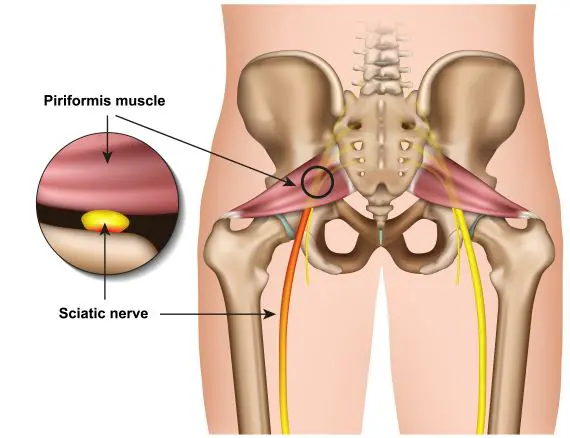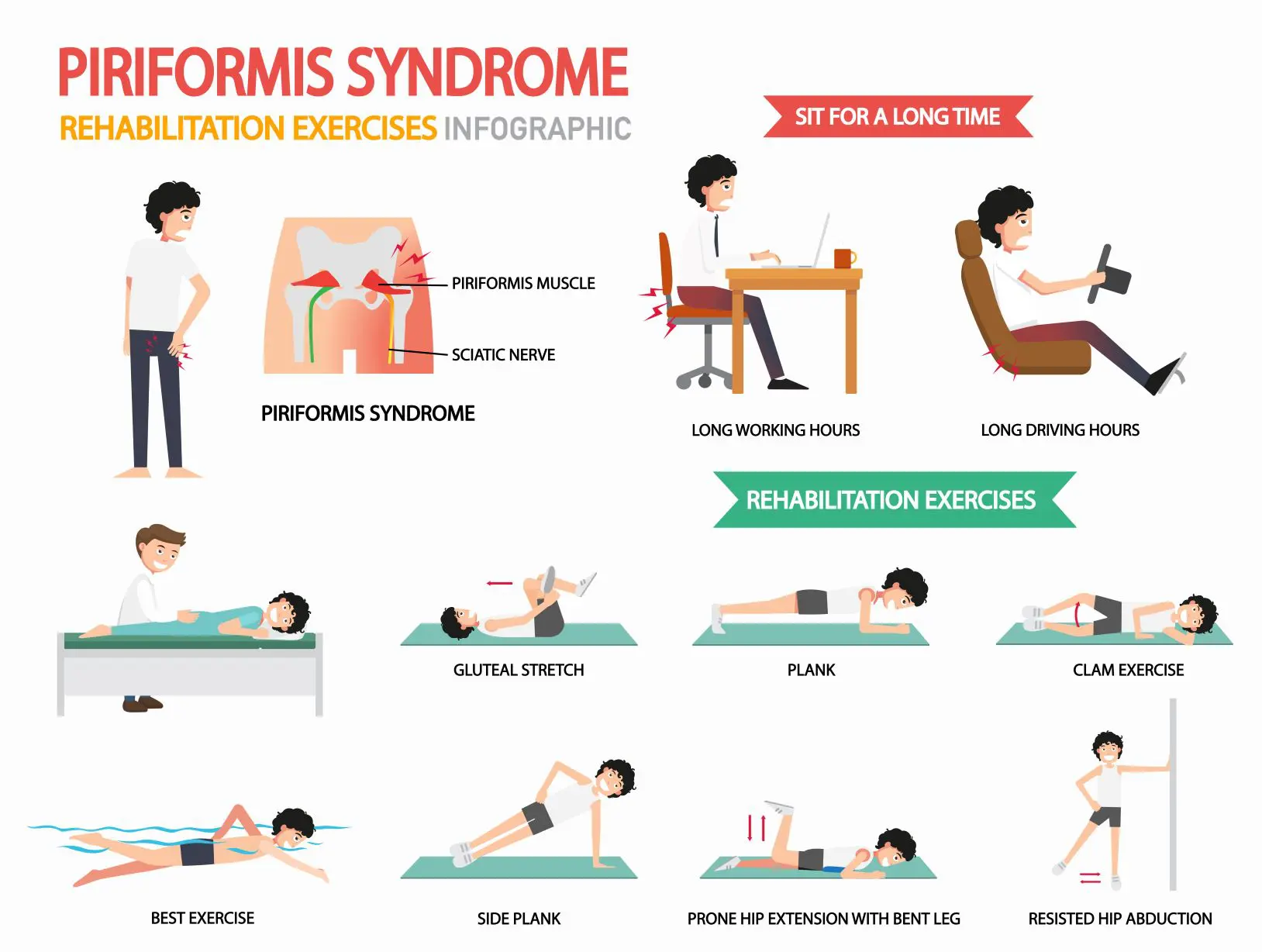What Do You Need to Know About Piriformis Syndrome?
Have you been feeling tightness in your buttock? Has it been more difficult for you to stand up and walk up and down the stairs without feeling pain radiating down your leg? Are you worried that you might have sciatica? Or maybe piriformis syndrome? Weren’t those two the same, you ask? Nope. – And we will explain why that is!
The Piriformis Muscle
The piriformis muscle is a flat muscle, pyramidal in shape, located in the gluteal region of the lower limbs. Its name comes from the Latin term “piriformis,” which translates in “pear-shaped.”
It is one of the six different muscles in the back of the hip that together turn the hip and therefore your toe outwards. Its primary task is to laterally rotate the femur with hip extension and abduct the femur with hip flexion. Thanks to the piriformis muscle, we can walk, shift our weight from one leg to another, and maintain balance while walking and standing.
The piriformis muscle is a very deep muscle that starts on the front part of the sacrum and sacroiliac joint, only to end up inserting itself into the great trochanter or the big bony part at the widest part of your hips. The sciatic nerve usually runs under the piriformis muscle, but in some people, the sciatic nerve runs directly through the muscle itself.

What Causes Piriformis syndrome?
Piriformis syndrome occurs from spasm or strain to the piriformis muscle that often results in pain in the buttock and posterior thigh. Rarely when the sciatic nerve pierces the piriformis muscle, the spasm irritates the nerve and causes pain to radiate down the leg. It is considered to be a diagnosis of exclusion as other problems need to be ruled out first. The reason for the spasm or strain causing piriformis syndrome is not completely clear, but there have been some suspicions as to what causes the symptoms of this syndrome. The possible causes include:
- Muscle spasm or trigger point in the piriformis muscle due to irritation that has occurred within it or irritation of the surrounding structures, such as the sacroiliac or hip joint
- Tightening of the piriformis muscle
- Swelling of the piriformis muscle
- Bleeding in the surrounding area of the piriformis muscle, etc.
- Dysfunction of the SI joint or hip joint
The Symptoms of Piriformis syndrome
In most cases, the first two symptoms that make doctors suspect that they are dealing with a case of piriformis syndrome are acute tenderness in the buttock and sciatica-like pain. Typical symptoms of piriformis syndrome include:
- Tightening of the piriformis muscle which causes dull pain in the buttock
- Pain radiating down the back of the thigh, calf, and foot, all through to the toes
- Numbness and tingling down the back of the thigh, calf, and foot, all through to the toes
- Acute pain when climbing up and down the stairs
- Reduced range of motion in the hip joint
- Increased pain with stooping or lifting
- Increasing pain during prolonged sitting down, etc.
Muscle knots in the piriformis are known to possibility refer pain to the buttocks, hip, back of the thigh, calf and/or the sole of the foot. The symptoms can variate from mild to more severe. In the most serious cases, the pain is known to become so severe that it causes an evident disability. The patient is no longer able to complete even the simplest, everyday activities such as walking, driving a car, or even sitting down without experiencing excruciating pain.
Treatment of Piriformis syndrome
People that have mild to moderate symptoms only may not need treatment, but those that have continued problems should seek medical help. The first step is to properly diagnose the issue by going to a medical doctor or your sports medicine chiropractor. A thorough work-up needs to be run to find the cause of your pain. The patients are, however, advised to consider the following techniques to reduce their symptoms:
- Resting by laying down in periods of acute pain
- Avoiding triggering activities such as climbing up and down the stairs, sitting down for a long time, standing up for a long time, etc.
- Applying hot and cold therapy on the buttocks and/or legs at home
- Using over-the-counter painkillers to soothe the pain (limited effectiveness)
- Stretching exercises for the piriformis muscle
- Strengthening exercises for the piriformis muscle, etc.

Other treatments that can be extremely effective at relieving piriformis syndrome include Graston Technique, chiropractic adjustments, Kinesio Taping and corrective exercises. Electric stimulation can also be used including interferential current (like at your chiropractor’s or a PT’s office) or even a portable unit for home use. By using electrical energy, it stimulates the nerves and interferes with the pain signals, stopping them on their way to the brain, thus causing the pain to lower.
In cases where the pain is so severe that it causes a disability, other approaches are available as well if it does not respond to conservative care. Usually, injections of corticosteroids are injected to help reduce any present inflammation within the muscle.
The difference between piriformis syndrome and sciatica
Many people make the mistake of thinking that piriformis syndrome and sciatica are all the same. When we talked about the common symptoms of piriformis syndrome, you may have recognized the characteristic symptoms of sciatica being mentioned, such as tingling and painful sensations radiating through the back of the thigh, calf, to the foot and toes. This may be telling you something. Remember that problems coming from the piriformis are usually going can be related to a knot in the muscle. This can mimic sciatica, but it is actually something else.
Sciatica is the term used to refer to this radiating pain and tingling sensation, which is being caused by a compression of the sciatic nerve. The sciatic nerve is the longest nerve in the human body, originating in the lower back, radiating deep from the buttocks, and continuing its way all down the leg while innervating various structures. If you remember, we mentioned the sciatic nerve passing either beneath or through the piriformis muscle.
One of the rare causes of sciatica is piriformis syndrome when the nerve passes through the muscle or is associated with tight fascia around the muscle. In these cases, it is the piriformis syndrome that causes pressure and irritation on the sciatic nerve, thus causing the characteristic symptoms to take place. This tells us that sciatica and piriformis syndrome are not the same, but rather sciatica develops as a consequence of piriformis syndrome. Sciatica is more commonly caused by problems related to the spine, like herniated discs and arthritis.
cONCLUSION
The piriformis syndrome, often mistaken for sciatica, is a condition which can cause serious disability. It can very easily make it hard to even stand up or sit down for long periods of time, because of the inflammation and pressure that it causes around your sciatic nerve. Although most cases are solved with lots of rest and some visits to your chiropractic sports physician, others require corticosteroid injections and even rarely surgery to relieve some of the pain that the patient has been dealing with.

